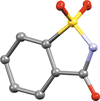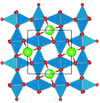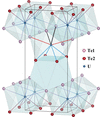issue contents
February 2020 issue

Cover illustration: An adenine–decavanadate molecular device reported in a crystal engineering study towards label-free chemical sensing and biological screening, see Sedghiniya et al. [(2020). Acta Cryst. B76, 85–92].
research papers
Download citation


Download citation


The crystal structure of the first synthetic copper tellurite arsenate, CuII5(TeIVO3)2(AsVO4)2, has been determined using single-crystal X-ray diffraction supplemented by Raman spectroscopic investigations.
CCDC reference: 1963274
Download citation


Download citation


A detailed description is given of the PbHfO3 incommensurate structure solved from single-crystal X-ray diffraction data measured with synchrotron radiation at 443 K. The 1D modulation vector varies slightly and monotonically with temperature. The structure modulation is mainly associated with the displacement of Pb2+ ions accompanied by HfO6 octahedral tilts.
B-IncStrDB reference: 16122E0qAs3
CCDC reference: 1963876
Download citation


Download citation


The thermal stability and solubility of chalcones increase with the number of heterocyclic rings which are present in the structure. (E)-1-(1H-Pyrrol-2-yl)-3-(thiophen-2-yl)prop-2-en-1-one and (E)-3-phenyl-1-(1H-pyrrol-2-yl)prop-2-en-1-one are compared with trans-chalcone, also known as (2E)-1,3-diphenylprop-2-en-1-one.
CCDC reference: 1952662
Download citation


Download citation


Open  access
access
 access
accessA high-Z′ structure of sodium saccharinate 1.875-hydrate has been found to be a commensurately modulated structure well described in (3+1)-dimensional superspace.
Download citation


Download citation


Rb9−xAg3+xSc2(WO4)9 (0 ≤ x ≤ 0.15 at 803 K) is a new structure type containing glaserite-like layers of {Ag3[Sc2(WO4)9]}9− groups separated by disordered Rb+ (Ag+) ions. The compound has a first-order superionic phase transition at 570 K with a sharp rise of electrical conductivity up to 1.8 × 10−3 S cm−1 at 690 K.
CCDC reference: 1965233
Radii of Cu+, Ag+, Au+ and Tl+ cations are determined by the additive method from interatomic distances in molecular and/or crystalline halides, oxides, chalcogenides and cyanides with different coordinations of atoms, and then recalculated for the 6-coordination number.
The structure of the mineral eudidymite (Na2Be2[Si[4]6O15]·H2O) is re-interpreted on the basis of the extended Zintl–Klemm concept. The donor atoms (Na, Be) convert the Si atoms into pseudo-P to form a three-connected Si-skeleton, characteristic of pentels (Group 15 elements), which are connected by fragments of the β-BeO structure.
Download citation


Download citation


The crystal structures of two closely related γ-brass phases in the Ir–Cd–Cu ternary system were compared using a cluster concept and layer description.
Download citation


Download citation


A high-pressure study of benzocaine has led to the discovery of a fourth polymorph.
A database containing thermochemical and structural information about 208 monotropic polymorphic forms has been created and analyzed. A systematic analysis of the reliability and limits of the applicability of the `density rule' to monotropic phases has been performed.
Download citation


Download citation


Structures of composite crystals SrxLi2+xAl2−xO4:Eu2+ were determined using a common structure model in (3+1)-dimensional superspace.
B-IncStrDB reference: 16142EOMIY2
Download citation


Download citation


The compound [AdH]6[V10O28]·4(H2O) containing 1H,9H-adeninium (AdH)+ and decavanadate (V10O28)6− has been successfully designed, synthesized and characterized via a hydrothermal process at 110°C. The title compound not only affords a label-free biosensor enabling selective recognition of nucleic acids but also expands the family of hybrid materials in the biological application realm from a luminescent screening point of view.
CCDC reference: 1910672
Download citation


Download citation


The puzzle of the complicated relations among composition, cooling rate and the incommensurate ordering of the plagioclase feldspar solid solution series is completed by filling in the well ordered structures of e-labradorite as one of the last pieces.
B-IncStrDB reference: 16192EpLfNa
High-energy X-ray diffraction data modelling, reverse Monte Carlo simulations, pair distribution function analysis and Rietveld refinement are described for strontium tellurite glass, anti-glass and crystalline samples.
The concept of the present study includes an analysis of the interactions of S and Se from cysteine (Cys), methionine (Met) selenocysteine (Sec) and selenomethionine (Mse) side chains in crystal structures retrieved from the Cambridge Structural Database (CSD), quantum-chemical insight into the strength of their individual interactions, and supramolecular differences between S and Se compounds based on biochemical recognition.
Download citation


Download citation


Open  access
access
 access
accessIn UTe2 the body-centred space group Immm (No. 71) persists down to the very low temperatures, where the unconventional superconductivity develops.
CCDC reference: 1972889


 journal menu
journal menu









































